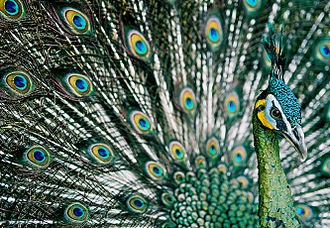Type the name of the breed you're looking for below
[wpdreams_ajaxsearchlite] Don't see the breed your're looking for? Click here and let us know!
Javanese Green Peafowl
| Origin | The Javanese Green peafowl was widely distributed in Southeast Asia in the past from eastern and north-eastern India, northern Myanmar and southern China, extending through Laos, and Thailand into Vietnam, Cambodia, Peninsular Malaysia and the islands of Java. |
| Size | Javanese Green peafowl can grow up to 39 in(100 cm) |
| Lifespan | Peafowl can live 3+ years |
| Noise | Peacocks have a loud call that, in the wild, is usually a sign of a predator nearby. |
| Characteristics | Green peafowl are large birds, amongst the largest living galliforms in terms of overall size, though rather lighter-bodied than the wild turkey, and perhaps the longest extant, wild bird in total length. Both sexes have long upper tail coverts which cover the actual tail underneath. In the male this extends up to two meters and is decorated with eyespots or ocelli while in the female the coverts are green and much shorter, just covering the tail. Outside the breeding season, however, the male's train is moulted and it can be difficult to distinguish the sexes unless they are observed up close. The neck and breast feathers of both sexes are iridescent green and resemble scales. In the male, the scapulars, median and greater wing coverts are blue while the lesser coverts are green and form a triangle of scaly feathers on the shoulder when the wing is closed. The secondaries are black and in some subspecies the tertials are brown and/or barred with a faint pattern. The female has blue lesser coverts and therefore lacks the triangle at the wing shoulder. Females also have neck scales fringed with copper as well as more barring on the back as well as the primaries and alula. Both sexes have shafted crests, and are long-legged, heavy-winged and long-tailed in silhouette. The crest of the female has slightly wider plumes while those of the male are thinner and taller. The facial skin is double striped with a white to light blue and beside the ear is a yellow to orange crescent. The dark triangle below the eye towards the eyebrow is bluish-green in the male and brown in the female. Seen from a distance, they are generally dark coloured birds with pale vermillion or buff coloured primaries which are quite visible in their peculiar flight which has been described as a true flapping flight with little gliding that one associates with Galliform birds. |
| Interaction/Time Requirements, Diet, Supplies Needed | The Javanese Green peafowl lives mainly on the ground in open forest or on land under cultivation where they forage for berries, grains but also prey on snakes, lizards, and small rodents. Because of the sheer size of these birds, they are most often kept in a large fenced yard during the day and locked away in a large aviary with perches at night to protect from predators. Always have a large dish or fountain accessible for the birds to drink. Aviaries can be bought ready to assemble or you can make your own. |



